Efficacy and Safety of a Novel Anhydrous 0.1% Retinal-Based Concentrate with Hydrophilic Actives for Photoaged Skin: A Six-Week Prospective Study
Abstract
1. Introduction
The Science and Efficacy of Retinoids in Skincare
- N-Acetyl Glucosamine (NAG) (1,5%): A precursor of hyaluronic acid that supports hydration and barrier function while inhibiting melanin production by downregulating tyrosinase, helping to reduce hyperpigmentation and improve skin elasticity [19].
- Ascorbic Acid (Vitamin C) (0.5%): A potent antioxidant that neutralizes free radicals, stimulates collagen synthesis, and inhibits tyrosinase activity to improve skin brightness and resilience [24].
- Alpha-Glucan Oligosaccharide (0.5%): A prebiotic ingredient that promotes a balanced skin microbiome, enhancing the skin’s natural defense mechanisms and potentially reducing skin sensitivity [25].
2. Materials and Methods
2.1. Study Design
2.2. Participants
- Diagnosed skin disorder (rosacea, eczema, acne, and psoriasis);
- Pregnancy and breastfeeding;
- Exposure to any cosmetic treatment (microneedling and strong chemical peels) in the last 6 months prior to the study period;
- Any use of botox or fillers prior to the study.
2.3. Biophysical Measurements
- Pigmentation;
- Fine lines and wrinkles;
- Skin texture and volume;
- Skin brightness (ITA°);
- Pore visibility;
- Redness (erythema).
2.3.1. Self-Evaluation Questionnaire
- Product gentleness;
- Wrinkle reduction;
- Firmness and elasticity;
- Glow and hydration;
- Evenness of skin tone;
- Reduction in pigment spots and pore visibility;
- Overall satisfaction with skin appearance;
- Reduced need for makeup.
2.3.2. Test Products
2.4. Statistical Analysis
Ethics
3. Results
3.1. Objective Measurements with Antera 3D
- Pigmentation: 12% reduction in hyperpigmentation (p < 0.0001);
- Fine Lines: 14% reduction in fine lines (p < 0.0001);
- Wrinkles: 5% improvement in wrinkle depth and severity (p = 0.0045);
- Texture: 12% improvement in skin smoothness (p < 0.0001);
- Volume: 15% reduction in skin irregularities (p < 0.0001);
- Skin Brightness: 4%-increase in ITA° (p = 0.0004);
- Pores: 24% reduction in pore visibility (p < 0.0001);
- Redness: No significant change in erythema (p = 0.6664).
3.2. Self-Evaluating Questionnaire
- 92% agreed that the products were gentle on their skin;
- 68% observed their wrinkles and/or fine lines were less prominent;
- 86% agreed their skin was smoother and more even;
- 71% agreed their skin felt firmer;
- 77% noted improved skin elasticity and suppleness;
- 78% reported an enhanced skin glow;
- 70% found their skin tone more even;
- 64% observed reduced pigment spot visibility;
- 60% agreed their pores were less visible;
- 83% noted softer and more hydrated skin;
- 81% expressed overall satisfaction with their skin condition;
- 43% felt they needed less makeup.
- 40% noticed visible improvements within 2 weeks;
- 74% within 4 weeks;
- 81% within 6 weeks.
4. Discussion
5. Conclusions
Author Contributions
Funding
Institutional Review Board Statement
Informed Consent Statement
Data Availability Statement
Conflicts of Interest
References
- Guinot, C.; Malvy, D.J.; Ambroisine, L.; Latreille, J.; Mauger, E.; Tenenhaus, M.; Morizot, F.; Lopez, S.; Le Fur, I.; Tschachler, E. Relative contribution of intrinsic vs extrinsic factors to skin aging as determined by a validated skin age score. Arch. Dermatol. 2002, 138, 1454–1460. [Google Scholar] [CrossRef]
- Brenneisen, P.; Sies, H.; Scharffetter-Kochanek, K. Ultraviolet-B irradiation and matrix metalloproteinases: From induction via signaling to initial events. Ann. N. Y. Acad. Sci. 2002, 973, 31–43. [Google Scholar] [CrossRef] [PubMed]
- Wlaschek, M.; Maity, P.; Makrantonaki, E.; Scharffetter-Kochanek, K. Connective Tissue and Fibroblast Senescence in Skin Aging. J. Investig. Dermatol. 2021, 141, 985–992. [Google Scholar] [CrossRef] [PubMed]
- Kim, Y.; Kang, B.; Kim, J.C.; Park, T.J.; Kang, H.Y. Senescent Fibroblast-Derived GDF15 Induces Skin Pigmentation. J. Investig. Dermatol. 2020, 140, 2478–2486.e2474. [Google Scholar] [CrossRef] [PubMed]
- Salminen, A.; Kaarniranta, K.; Kauppinen, A. Photoaging: UV radiation-induced inflammation and immunosuppression accelerate the aging process in the skin. Inflamm. Res. 2022, 71, 817–831. [Google Scholar] [CrossRef]
- Kang, H.Y.; Lee, J.W.; Papaccio, F.; Bellei, B.; Picardo, M. Alterations of the pigmentation system in the aging process. Pigment Cell Melanoma Res. 2021, 34, 800–813. [Google Scholar] [CrossRef]
- Gilchrest, B.A.; Blog, F.B.; Szabo, G. Effects of aging and chronic sun exposure on melanocytes in human skin. J. Investig. Dermatol. 1979, 73, 141–143. [Google Scholar] [CrossRef]
- Gillum, H.L.; Morgan, A.F.; Sailer, F. Nutritional status of the aging. V. Vitamin A and carotene. J. Nutr. 1955, 55, 655–670. [Google Scholar] [CrossRef]
- Oikarinen, A.; Peltonen, J.; Kallioinen, M. Ultraviolet radiation in skin ageing and carcinogenesis: The role of retinoids for treatment and prevention. Ann. Med. 1991, 23, 497–505. [Google Scholar] [CrossRef]
- Kligman, A.M. Topical treatments for photoaged skin. Separating the reality from the hype. Postgrad. Med. 1997, 102, 115–118, 123–126. [Google Scholar] [CrossRef]
- Kligman, A.M. The treatment of acne with topical retinoids: One man’s opinions. J. Am. Acad. Dermatol. 1997, 36 Pt 2, S92–S95. [Google Scholar] [CrossRef]
- Kligman, A.M. An extremely effective treatment for serious inflammatory acne: An uncontrolled, unblinded, unstatistical office study. Cutis 1997, 59, 109–110. [Google Scholar]
- Mukherjee, S.; Date, A.; Patravale, V.; Korting, H.C.; Roeder, A.; Weindl, G. Retinoids in the treatment of skin aging: An overview of clinical efficacy and safety. Clin. Interv. Aging 2006, 1, 327–348. [Google Scholar] [CrossRef]
- Sitohang, I.B.S.; Makes, W.I.; Sandora, N.; Suryanegara, J. Topical tretinoin for treating photoaging: A systematic review of randomized controlled trials. Int. J. Womens Dermatol. 2022, 8, e003. [Google Scholar] [CrossRef]
- Weiss, J.S.; Ellis, C.N.; Headington, J.T.; Tincoff, T.; Hamilton, T.A.; Voorhees, J.J. Topical tretinoin improves photoaged skin. A double-blind vehicle-controlled study. JAMA 1988, 259, 527–532. [Google Scholar] [CrossRef] [PubMed]
- D’Ambrosio, D.N.; Clugston, R.D.; Blaner, W.S. Vitamin A metabolism: An update. Nutrients 2011, 3, 63–103. [Google Scholar] [CrossRef] [PubMed]
- Temova Rakusa, Z.; Skufca, P.; Kristl, A.; Roskar, R. Retinoid stability and degradation kinetics in commercial cosmetic products. J. Cosmet. Dermatol. 2021, 20, 2350–2358. [Google Scholar] [CrossRef] [PubMed]
- Temova Rakusa, Z.; Skufca, P.; Kristl, A.; Roskar, R. Quality control of retinoids in commercial cosmetic products. J. Cosmet. Dermatol. 2021, 20, 1166–1175. [Google Scholar] [CrossRef]
- Kimball, A.B.; Kaczvinsky, J.R.; Li, J.; Robinson, L.R.; Matts, P.J.; Berge, C.A.; Miyamoto, K.; Bissett, D.L. Reduction in the appearance of facial hyperpigmentation after use of moisturizers with a combination of topical niacinamide and N-acetyl glucosamine: Results of a randomized, double-blind, vehicle-controlled trial. Br. J. Dermatol. 2010, 162, 435–441. [Google Scholar] [CrossRef]
- Bissett, D.L.; Miyamoto, K.; Sun, P.; Li, J.; Berge, C.A. Topical niacinamide reduces yellowing, wrinkling, red blotchiness, and hyperpigmented spots in aging facial skin. Int. J. Cosmet. Sci. 2004, 26, 231–238. [Google Scholar] [CrossRef]
- Bissett, D.L.; Oblong, J.E.; Berge, C.A. Niacinamide: A B vitamin that improves aging facial skin appearance. Dermatol. Surg. 2005, 31 Pt 2, 860–865; discussion 865. [Google Scholar] [CrossRef] [PubMed]
- Draelos, Z.D.; Matsubara, A.; Smiles, K. The effect of 2% niacinamide on facial sebum production. J. Cosmet. Laser Ther. 2006, 8, 96–101. [Google Scholar] [CrossRef] [PubMed]
- Lee, D.H.; Oh, I.Y.; Koo, K.T.; Suk, J.M.; Jung, S.W.; Park, J.O.; Kim, B.J.; Choi, Y.M. Reduction in facial hyperpigmentation after treatment with a combination of topical niacinamide and tranexamic acid: A randomized, double-blind, vehicle-controlled trial. Skin Res. Technol. 2014, 20, 208–212. [Google Scholar] [CrossRef] [PubMed]
- Gillbro, J.M.; Olsson, M.J. The melanogenesis and mechanisms of skin-lightening agents—Existing and new approaches. Int. J. Cosmet. Sci. 2011, 33, 210–221. [Google Scholar] [CrossRef]
- Han, J.H.; Kim, H.S. Skin Deep: The Potential of Microbiome Cosmetics. J. Microbiol. 2024, 62, 181–199. [Google Scholar] [CrossRef]
- Hurley, S.; Messaraa, C.; O’Connor, C.; Metois, A.; Walsh, M.; Mc Namee, D.; Mansfield, A.; Robertson, N.; Doyle, L.; Mavon, A. DermaTOP Blue and Antera 3D as methods to assess cosmetic solutions targeting eyelid sagging. Skin Res. Technol. 2020, 26, 209–214. [Google Scholar] [CrossRef]
- Messaraa, C.; Metois, A.; Walsh, M.; Hurley, S.; Doyle, L.; Mansfield, A.; O’Connor, C.; Mavon, A. Wrinkle and roughness measurement by the Antera 3D and its application for evaluation of cosmetic products. Skin Res. Technol. 2018, 24, 359–366. [Google Scholar] [CrossRef]
- Matias, A.R.; Ferreira, M.; Costa, P.; Neto, P. Skin colour, skin redness and melanin biometric measurements: Comparison study between Antera® 3D, Mexameter® and Colorimeter®. Skin Res. Technol. 2015, 21, 346–362. [Google Scholar] [CrossRef]
- Kwon, H.S.; Lee, J.H.; Kim, G.M.; Bae, J.M. Efficacy and safety of retinaldehyde 0.1% and 0.05% creams used to treat photoaged skin: A randomized double-blind controlled trial. J. Cosmet. Dermatol. 2018, 17, 471–476. [Google Scholar] [CrossRef]
- Mambwe, B.; Mellody, K.T.; Kiss, O.; O’Connor, C.; Bell, M.; Watson, R.E.B.; Langton, A.K. Cosmetic retinoid use in photoaged skin: A review of the compounds, their use and mechanisms of action. Int. J. Cosmet. Sci. 2025, 47, 45–57. [Google Scholar] [CrossRef]
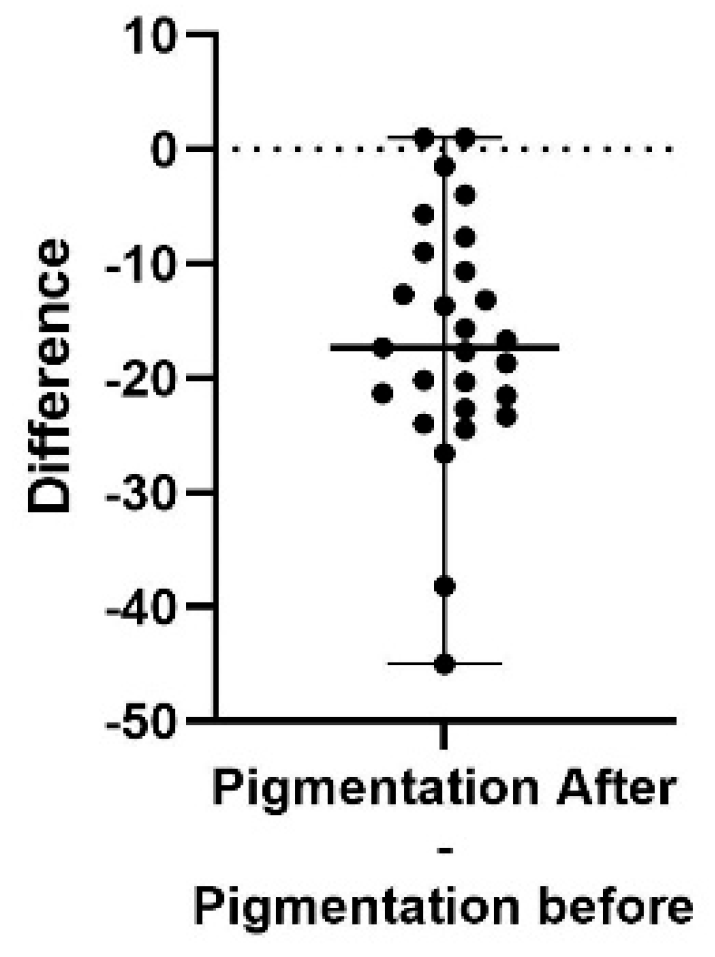

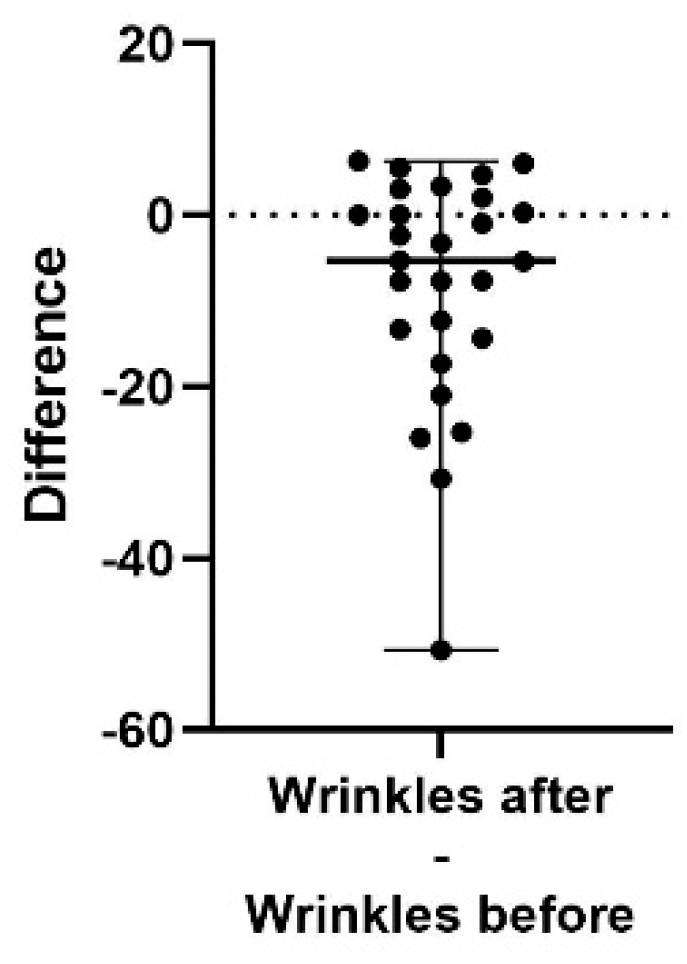


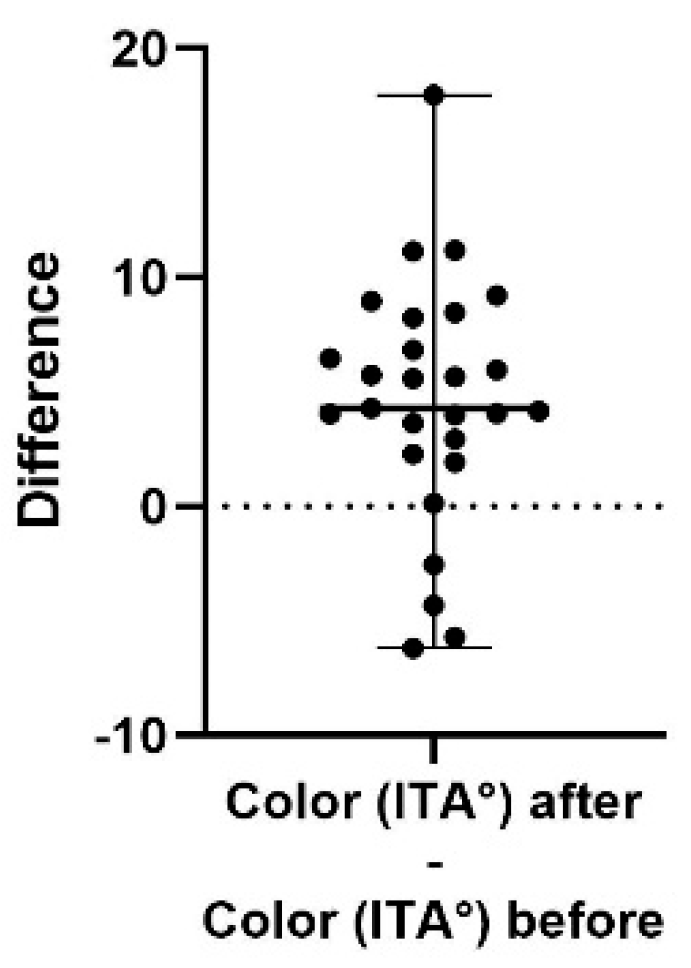

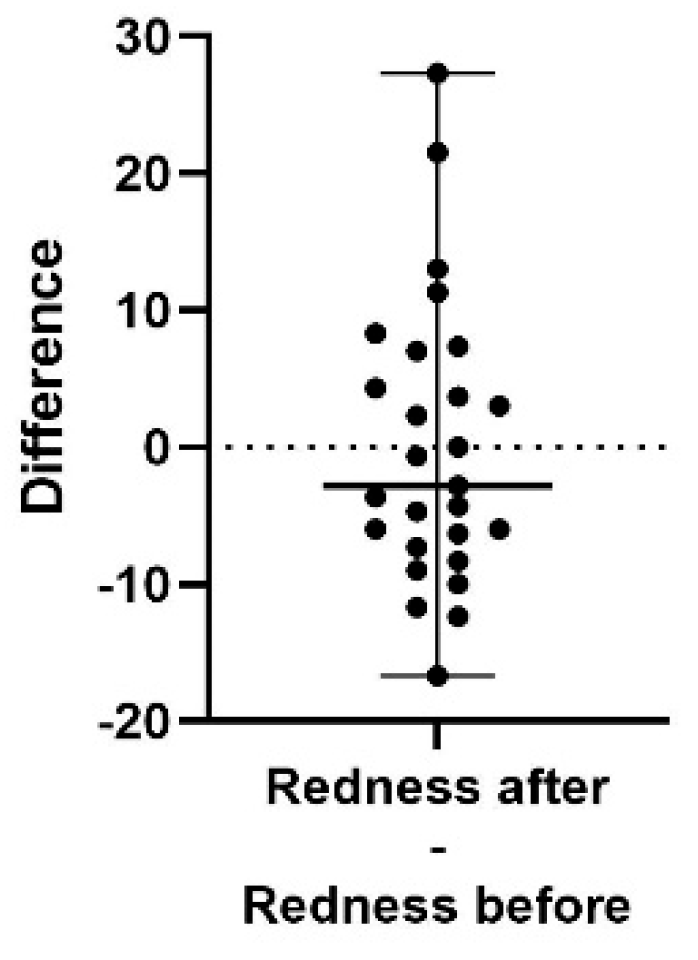


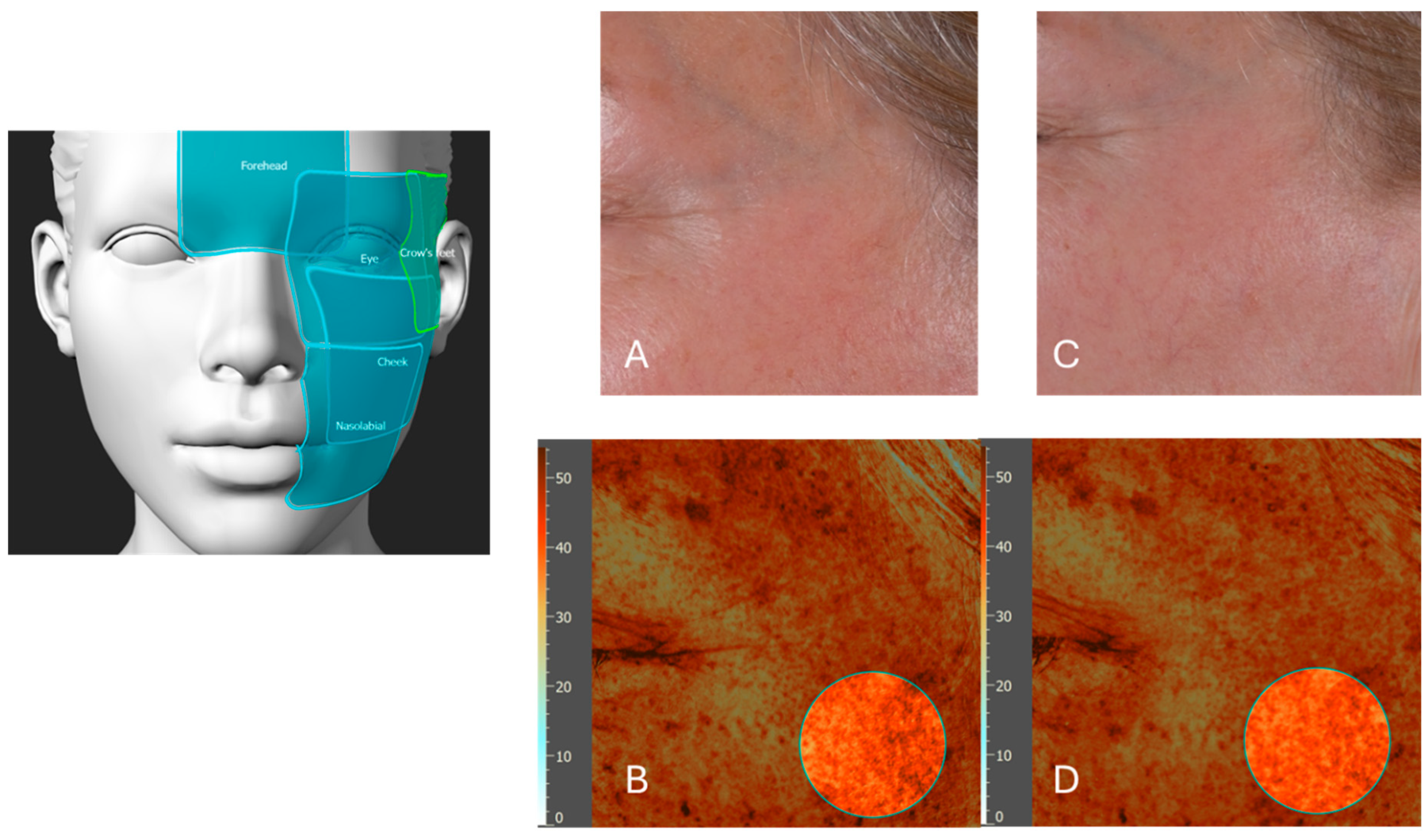
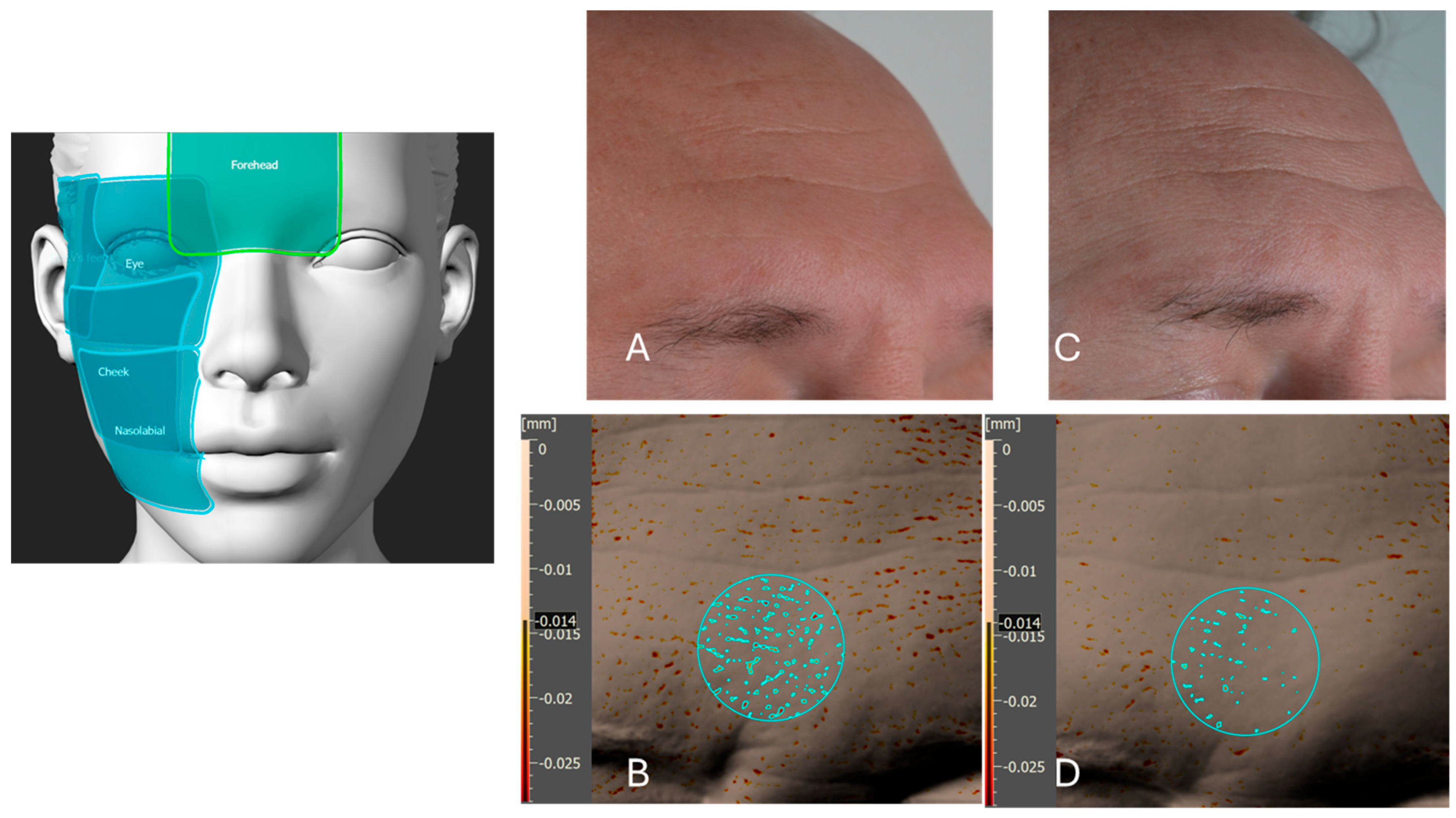
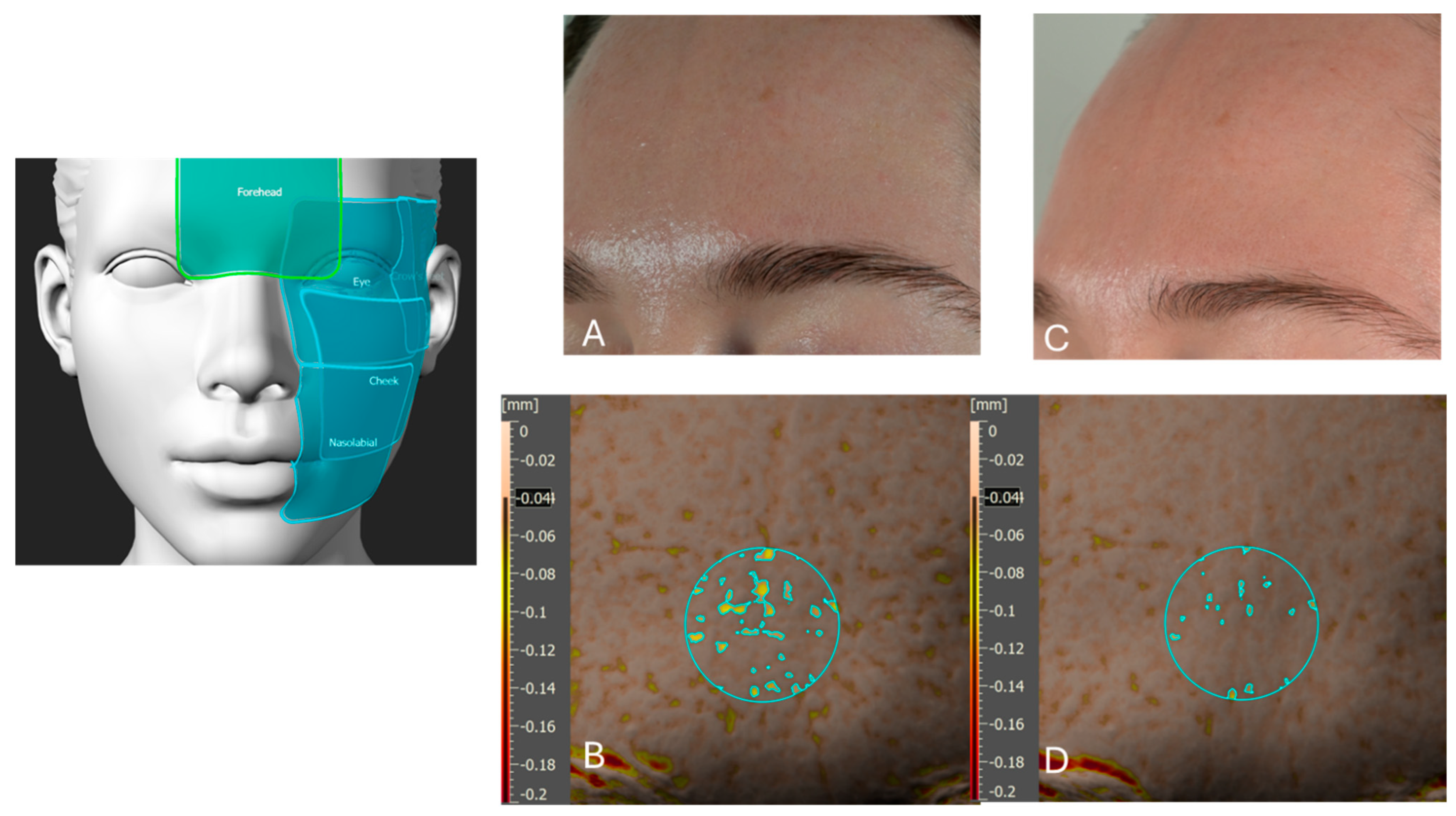
| Squalane, Caprylic/Capric Triglyceride, Hydrogenated Vegetable Oil, Acetyl Glucosamine, Niacinamide, Alpha-Glucan Oligosaccharide, Ascorbic Acid, and Retinal |
| Aqua, Cetearyl Alcohol, Stearic Acid, Glycerin, Kaolin, Coco-Betaine, Polyglyceryl3 Dicitrate/Stearate, C10–18 Triglycerides, Lactobacillus Ferment, Avena Sativa Kernel Oil, Caprylic/Capric Triglyceride, Sodium Methyl Cocoyl Taurate, Squalane, Niacinamide, Dextrin, Polydextrose, Amylopectin, Sodium Cocoyl Isethionate, and Salicylic Acid |
| Aqua, Glycerin, Squalane, Niacinamide, Coco-Caprylate/Caprate, Lactobacillus/Rice Ferment, Jojoba Esters, Lactobionic Acid, Zinc Gluconate, Ectoin, Urea, Hydrogenated Lecithin, Stearyl Alcohol, Maltitol, Arginine, Tocopherol, Dehydroxanthan Gum, and Sodium Hydroxide |
| Aqua, Jojoba Esters, Squalane, Vegetable Oil, Glycerin, Hydrogenated Vegetable Oil, Stearyl Alcohol, Glyceryl Stearate, Lactobionic Acid, Urea, Phytosterol, Ceramide NP, Zinc PCA, Calcium PCA, Sodium Stearoyl Glutamate, Tocopherol, Sodium Polyacryloyldimethyl Taurate, and Sodium Hydroxide |
| Aqua, Vegetable Oil, Squalane, Glycerin, Bis Diglyceryl Polyacyladipate-2, Glyceryl Stearate, Caprylic/Capric Triglyceride, Stearyl Alcohol, Ectoin, Urea, Zinc PCA, Lactobionic Acid, Calcium PCA, Lysolecithin, Ceramide NP, Sodium Stearoyl Glutamate, Sclerotium Gum, and Sodium Hydroxide |
Disclaimer/Publisher’s Note: The statements, opinions and data contained in all publications are solely those of the individual author(s) and contributor(s) and not of MDPI and/or the editor(s). MDPI and/or the editor(s) disclaim responsibility for any injury to people or property resulting from any ideas, methods, instructions or products referred to in the content. |
© 2025 by the authors. Licensee MDPI, Basel, Switzerland. This article is an open access article distributed under the terms and conditions of the Creative Commons Attribution (CC BY) license (https://creativecommons.org/licenses/by/4.0/).
Share and Cite
Åkerström, U.; Gaudicheau, C.; Locret, B.; Gillbro, J.M. Efficacy and Safety of a Novel Anhydrous 0.1% Retinal-Based Concentrate with Hydrophilic Actives for Photoaged Skin: A Six-Week Prospective Study. Cosmetics 2025, 12, 235. https://doi.org/10.3390/cosmetics12060235
Åkerström U, Gaudicheau C, Locret B, Gillbro JM. Efficacy and Safety of a Novel Anhydrous 0.1% Retinal-Based Concentrate with Hydrophilic Actives for Photoaged Skin: A Six-Week Prospective Study. Cosmetics. 2025; 12(6):235. https://doi.org/10.3390/cosmetics12060235
Chicago/Turabian StyleÅkerström, Ulf, Chloé Gaudicheau, Blandine Locret, and Johanna Maria Gillbro. 2025. "Efficacy and Safety of a Novel Anhydrous 0.1% Retinal-Based Concentrate with Hydrophilic Actives for Photoaged Skin: A Six-Week Prospective Study" Cosmetics 12, no. 6: 235. https://doi.org/10.3390/cosmetics12060235
APA StyleÅkerström, U., Gaudicheau, C., Locret, B., & Gillbro, J. M. (2025). Efficacy and Safety of a Novel Anhydrous 0.1% Retinal-Based Concentrate with Hydrophilic Actives for Photoaged Skin: A Six-Week Prospective Study. Cosmetics, 12(6), 235. https://doi.org/10.3390/cosmetics12060235





